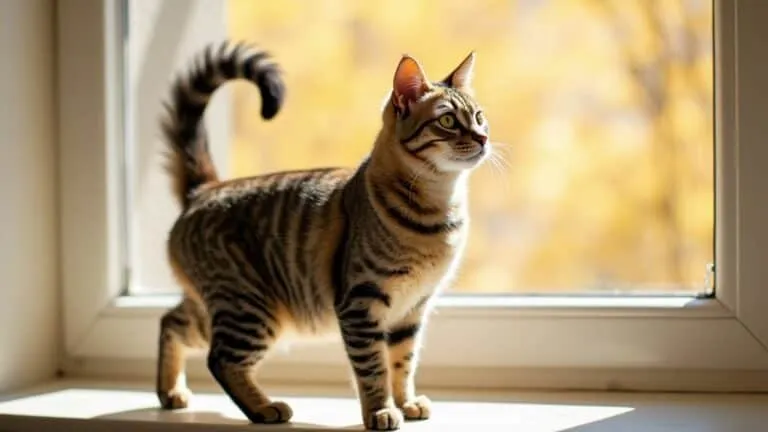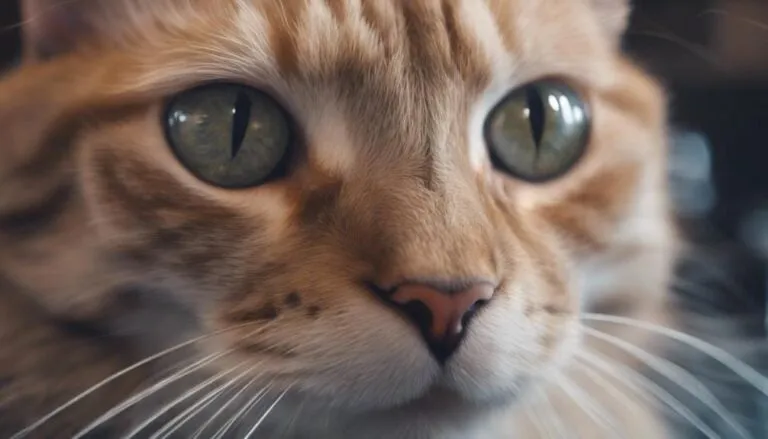The Best Fluffy Pancakes recipe you will fall in love with. Full of tips and tricks to help you make the best pancakes.

Have you ever wondered if there is a deeper meaning behind your cat's mysterious circle-walking ritual? It's a behavior that has captivated cat owners for generations, and today we will explore the fascinating theories that attempt to decode this intriguing behavior.
From ancient instincts and territorial marking to the influence of their environment, there are many factors that could shed light on why cats engage in this peculiar ritual.
So, if you're curious to uncover the secrets behind your feline friend's circle-walking, join us as we embark on a journey to unravel the mysteries of cat behavior.
Key Takeaways
- Cats walk in circles before lying down as a leftover instinct from their wild ancestors.
- Walking in circles helps cats mark their territory and check for potential threats or dangers.
- Cats use their senses of smell, touch, vision, and hearing to navigate their environment and assess the area before lying down.
- The environment, including the texture of the surface and temperature, can influence a cat's tendency to walk in circles.
Origins of Circle Walking
The circle walking behavior observed in cats before lying down is believed to have originated from their wild ancestors and serves various purposes. Evolutionary instincts play a significant role in this behavior.
Cats in the wild would circle before lying down to flatten grass or leaves, creating a comfortable resting spot. This instinct has been passed down through generations, even in domesticated cats.
Cultural influences also contribute to this behavior. Cats may walk in circles to mark their territory, as they've a strong instinct to establish boundaries.
Additionally, circling helps cats find the best position to conserve body heat, which is crucial for their survival in colder environments.
Understanding the evolutionary and cultural factors behind this behavior can help us better comprehend our feline companions' instincts and needs.
How Cats Use Their Senses
Cats rely on their senses to navigate their environment and gather information about their surroundings. Here's how they use their senses to navigate their surroundings and the role of smell in their behavior:
- Smell: Cats have a highly developed sense of smell, which they use to pick up scents that indicate the presence of predators, prey, or other cats. This helps them assess the safety of their environment and identify potential threats.
- Touch: Cats rely on their sense of touch, particularly in their paws, to assess the texture and temperature of the ground. This helps them determine if a spot is comfortable and suitable for lying down.
- Vision: Cats have excellent vision, allowing them to assess the area before lying down. They can spot any potential dangers or changes in their surroundings.
- Hearing: Cats have a highly developed sense of hearing, allowing them to detect even the slightest sounds. This helps them stay alert and aware of their surroundings, ensuring their safety.
The sense of smell plays a crucial role in a cat's behavior, helping them navigate their environment and gather information about their surroundings. By relying on their senses, cats can assess the safety and comfort of their environment, ensuring they find the best spot to rest.
Environmental Factors and Behavior
After understanding how cats use their senses to navigate their environment, it's important to explore the influence of environmental factors on their behavior.
The temperature of the environment can have an impact on a cat's tendency to walk in circles before lying down. Cats prefer warm and cozy spots for sleeping, so they may be more likely to engage in circle walking on soft surfaces like bedding or carpet.
Additionally, the role of enrichment in cat behavior shouldn't be overlooked. Providing a stimulating environment with toys, scratching posts, and hiding spots can help prevent behavioral issues and promote positive behaviors in cats.
Cats are highly adaptable creatures and can adjust their behavior based on their environment, so it's crucial to create a safe and enriched environment for them to thrive.
The Influence of Domestication
Through the process of domestication, cats have undergone significant behavioral changes that have made them more sociable and adaptable to human environments. This has resulted in a stronger bond between cats and humans, as well as noticeable effects on cat behavior.
Here are four key ways in which domestication has influenced cat behavior:
- Increased sociability: Domesticated cats have become more tolerant of human interactions and seek companionship from their owners.
- Adaptability to human environments: Cats have adjusted their behavior to live in close proximity to humans, becoming more reliant on their presence.
- Retention of wild instincts: While domesticated, cats have retained some of their wild instincts, such as hunting and marking territory.
- Development of specific traits and behaviors: The process of domestication has led to the development of various cat breeds with distinct characteristics and behaviors.
Understanding Cat Behavior and Body Language
As we continue our exploration of cat behavior, let's now turn our attention to understanding the fascinating world of cat behavior and body language. It's important to debunk common misconceptions and address common behavioral issues that cat owners may encounter.
One common misconception is that cats walking in circles before lying down is a cause for concern. However, this behavior is usually nothing to worry about. Cats often walk in circles to test the ground, mark their territory, stretch their muscles, or find the best position to conserve body heat.
Understanding your cat's body language is crucial in interpreting their behavior. Cats communicate through tail position, ear position, and facial expressions. Purring, for example, isn't always a sign of contentment; cats may also purr when anxious or in pain. Aggressive behaviors like hissing or swatting can indicate that a cat feels threatened or uncomfortable.
Frequently Asked Questions
Can Circle Walking Before Lying Down Be a Sign of a Health Issue in Cats?
Circle walking before lying down in cats is usually not a sign of a health issue. It's more likely a quirky behavior linked to instincts, marking territory, testing the ground, or stretching muscles.
Do All Cats Walk in Circles Before Lying Down, or Is It Only a Behavior Exhibited by Some Cats?
Do all cats walk in circles before lying down? Circle walking is a behavior exhibited by some cats. It has significance in cat behavior, serving as an instinctual leftover, a way to mark territory, and a means to test the ground.
Can Circling Behavior Change Over Time in Cats?
Yes, circling behavior in cats can change over time due to evolutionary origins and psychological factors. It may be influenced by changes in their environment, health, age, or social dynamics.
Are There Any Specific Breeds of Cats That Are More Likely to Exhibit Circle Walking Behavior?
Circle walking behavior can vary among cat breeds. Some breeds, like the Siamese or Burmese, are known to exhibit this behavior more frequently. However, it's important to note that circle walking can also be a result of learned behavior in cats.
How Can Cat Owners Create a Stimulating Environment for Their Cats to Prevent Behavioral Issues?
To create a stimulating environment for your cat and prevent behavioral issues, provide toys, scratching posts, and hiding spots. Offer interactive playtime and puzzle feeders. Rotate toys and provide vertical spaces. Use positive reinforcement and reward-based training.
Conclusion
In conclusion, the mysterious circle-walking ritual in cats is a behavior that can be traced back to their wild ancestors. It serves multiple purposes such as marking territory and conserving body heat.
Cats rely on their senses to navigate their environment, and the surrounding environment can greatly influence their behavior. Domestication has also played a role in shaping cat behavior. Understanding your cat's body language is crucial for their well-being.
Interestingly, a study found that 80% of cats exhibit circle-walking behavior before settling down for a nap, highlighting its prevalence among feline friends.








